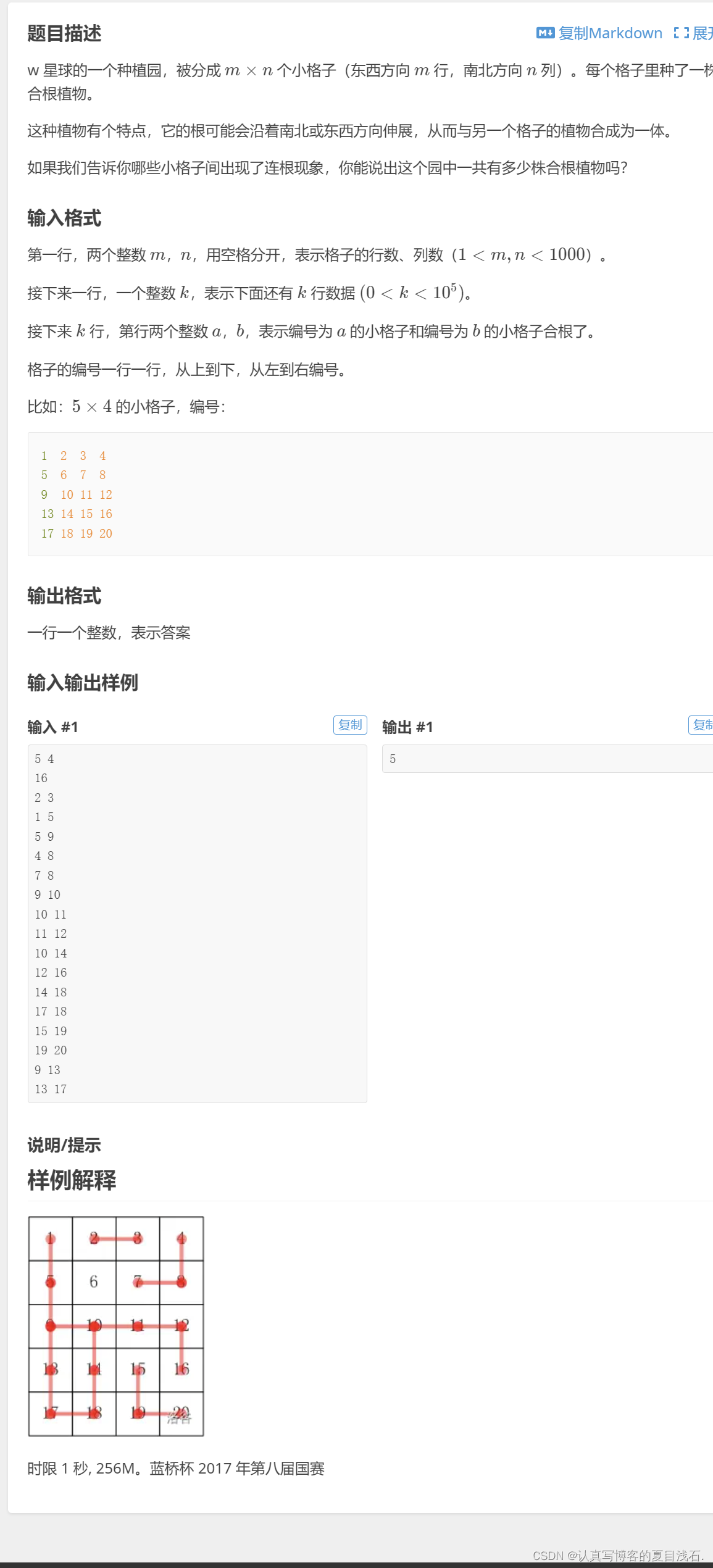1 统计指标
- 随机变量XXX的理论平均值称为期望: μ=E(X)\mu = E(X)μ=E(X)
- 但现实中通常不知道μ\muμ, 因此使用已知样本来获取均值
X‾=1n∑i=1nXi.\overline{X} = \frac{1}{n} \sum_{i = 1}^n X_i. X=n1i=1∑nXi. - 方差variance定义为:
σ2=E(∣X−μ∣2).\sigma^2 = E(|X - \mu|^2). σ2=E(∣X−μ∣2). - 用已知样本的数据来代替:
S2=Var(X)=1n∑i=1n(Xi−μ)2.S^2 = Var(X) = \frac{1}{n} \sum_{i = 1}^n (X_i - \mu)^2. S2=Var(X)=n1i=1∑n(Xi−μ)2. - 由于μ\muμ未知, 使用贝塞尔校正:
S2=Var(X)=1n−1∑i=1n(Xi−X‾)2.S^2 = Var(X) = \frac{1}{n - 1} \sum_{i = 1}^{n} (X_i - \overline{X})^2. S2=Var(X)=n−11i=1∑n(Xi−X)2. - 原因: 在已知数据上, 使用X‾\overline{X}X获得的结果一般更小:
∑i=1n−1(Xi−X‾)2≤∑i=1n−1(Xi−μ)2.\sum_{i = 1}^{n - 1} (X_i - \overline{X})^2 \leq \sum_{i = 1}^{n - 1} (X_i - \mu)^2. i=1∑n−1(Xi−X)2≤i=1∑n−1(Xi−μ)2. - 更多解释: https://www.zhihu.com/question/20099757
- 标准差:
σX=S=Var(X).\sigma_X = S = \sqrt{Var(X)}. σX=S=Var(X).
偏差与方差:
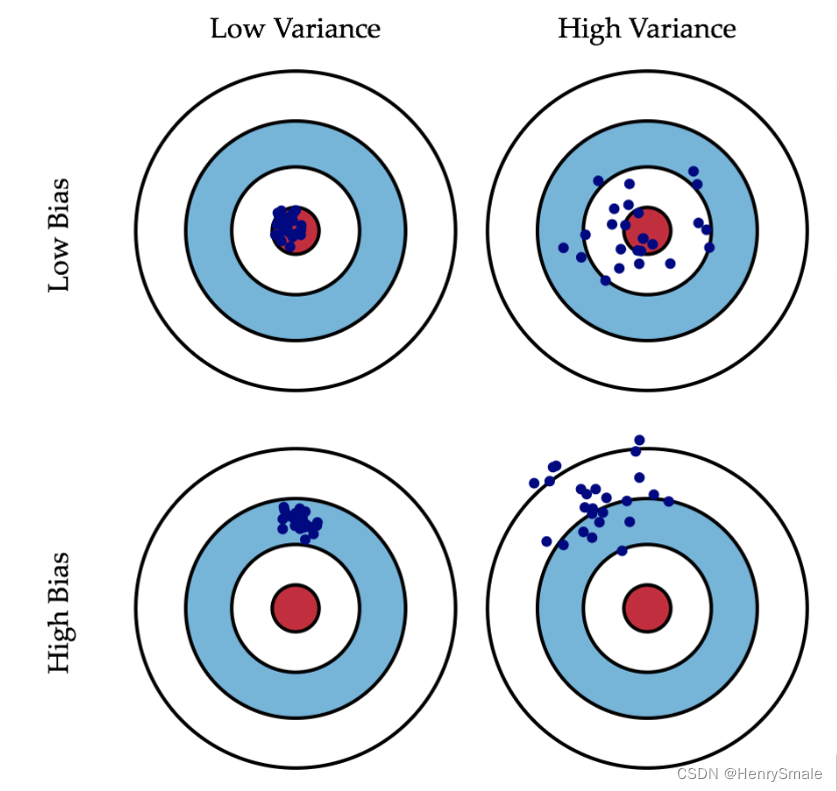
- 方差(again)
Var(X)=σX2=1n−1∑i=1n(Xi−X‾)(Xi−X‾).Var(X) = \sigma_X^2 = \frac{1}{n - 1} \sum_{i = 1}^{n} (X_i - \overline{X})(X_i - \overline{X}). Var(X)=σX2=n−11i=1∑n(Xi−X)(Xi−X). - 协方差
Cov(X,Y)=1n−1∑i=1n(Xi−X‾)(Yi−Y‾).Cov(X, Y) = \frac{1}{n - 1} \sum_{i = 1}^{n} (X_i - \overline{X})(Y_i - \overline{Y}). Cov(X,Y)=n−11i=1∑n(Xi−X)(Yi−Y). - Pearson相关系数
Corr(X,Y)=ρX,Y=Cov(X,Y)σXσY.Corr(X, Y) = \rho_{X, Y} = \frac{Cov(X, Y)}{\sigma_X \sigma_Y}. Corr(X,Y)=ρX,Y=σXσYCov(X,Y).
2 线性回归
2.1 回归任务
分类与回归
- 分类任务预测类别,即是/否等离散值:如是否生病;
- 回归任务预测实型值:如气温
拟合空间中的点 (注意数据点没有类别标记, 输出也占一维):
- 一个条件属性:直线;
- 两个条件属性:平面;
- 更多条件属性:超平面.
拟合线:
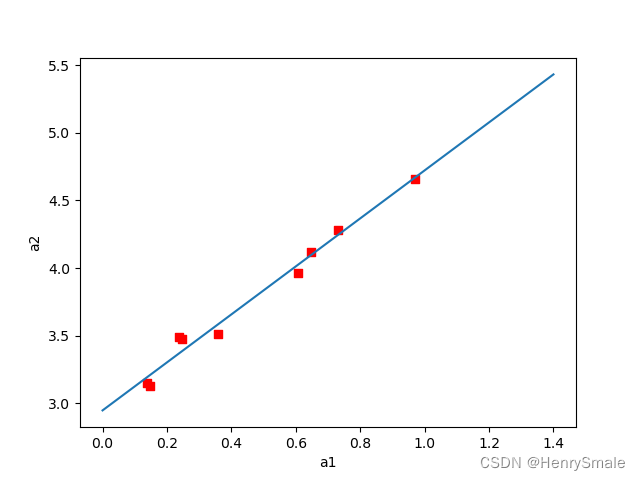
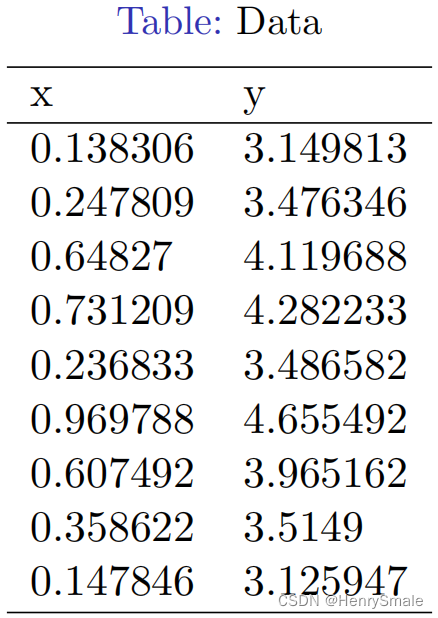
2.2 最小二乘法
线性分割面的表达
- 平面几何表达直线(两个系数):
y=ax+b.y = ax + b.y=ax+b. - 重新命名变量:
w0+w1x1=y.w_0 + w_1 x_1 = y.w0+w1x1=y. - 强行加一个x0≡1x_0 \equiv 1x0≡1:
w0x0+w1x1=y.w_0 x_0 + w_1 x_1 = y.w0x0+w1x1=y. - 向量表达:
xw=y\mathbf{xw} = yxw=y
与Logistic regression相比: w\mathbf{w}w和x\mathbf{x}x均少了一维。
损失函数
∑i=1m(xiw−yi)2.\sum_{i = 1}^m (\mathbf{x}_i\mathbf{w} - y_i)^2. i=1∑m(xiw−yi)2.
矩阵化的表达:
∥Xw−Y∥2.\|\mathbf{X} \mathbf{w} - \mathbf{Y}\|^2. ∥Xw−Y∥2.
矩阵化的展开式:
L(X,Y,w)=(Xw−Y)T(Xw−Y).L(\mathbf{X}, \mathbf{Y}, \mathbf{w}) = (\mathbf{X} \mathbf{w} - \mathbf{Y})^\mathrm{T}(\mathbf{X} \mathbf{w} - \mathbf{Y}). L(X,Y,w)=(Xw−Y)T(Xw−Y).
求解推导
L(X,Y,w)=(Xw−Y)T(Xw−Y)=(wTXT−YT)(Xw−Y)=wTXTXw−wTXTY−YTXw+YTY\begin{array}{l} L(\mathbf{X}, \mathbf{Y}, \mathbf{w})\\ = (\mathbf{X} \mathbf{w} - \mathbf{Y})^\mathrm{T}(\mathbf{X} \mathbf{w} - \mathbf{Y})\\ = (\mathbf{w}^\mathrm{T}\mathbf{X}^\mathrm{T} - \mathbf{Y}^\mathrm{T})(\mathbf{X} \mathbf{w} - \mathbf{Y})\\ = \mathbf{w}^\mathrm{T}\mathbf{X}^\mathrm{T}\mathbf{X} \mathbf{w} - \mathbf{w}^\mathrm{T}\mathbf{X}^\mathrm{T}\mathbf{Y} - \mathbf{Y}^\mathrm{T}\mathbf{X}\mathbf{w} + \mathbf{Y}^\mathrm{T}\mathbf{Y} \end{array} L(X,Y,w)=(Xw−Y)T(Xw−Y)=(wTXT−YT)(Xw−Y)=wTXTXw−wTXTY−YTXw+YTY
为最小化该函数, 应对w\mathbf{w}w求导, 且其结果为0。
根据矩阵求导法则:
∂Aw∂w=A,∂wTA∂w=AT,∂wTAw∂w=2wTA.\begin{array}{l} \frac{\partial A \mathbf{w}}{\partial \mathbf{w}} = A,\\ \frac{\partial \mathbf{w}^{\mathrm{T}} A}{\partial \mathbf{w}} = A^{\mathrm{T}},\\ \frac{\partial \mathbf{w}^{\mathrm{T}} A \mathbf{w}}{\partial \mathbf{w}} = 2 \mathbf{w}^{\mathrm{T}} A. \end{array} ∂w∂Aw=A,∂w∂wTA=AT,∂w∂wTAw=2wTA.
可知:
∂L(X,Y,w)∂w=∂wTXTXw∂w−∂wTXTY∂w−∂YTXw∂w+∂YTY∂w=2wTXTX−YTX−YTX+0=2wTXTX−2YTX\begin{array}{l} \frac{\partial L(\mathbf{X}, \mathbf{Y}, \mathbf{w})}{\partial \mathbf{w}}\\ = \frac{\partial \mathbf{w}^\mathrm{T}\mathbf{X}^\mathrm{T}\mathbf{X} \mathbf{w}}{\partial \mathbf{w}} - \frac{\partial \mathbf{w}^\mathrm{T}\mathbf{X}^\mathrm{T}\mathbf{Y}}{\partial \mathbf{w}} - \frac{\partial \mathbf{Y}^\mathrm{T}\mathbf{X}\mathbf{w}}{\partial \mathbf{w}} + \frac{\partial \mathbf{Y}^\mathrm{T}\mathbf{Y}}{\partial \mathbf{w}}\\ = 2 \mathbf{w}^\mathrm{T}\mathbf{X}^\mathrm{T}\mathbf{X} - \mathbf{Y}^\mathrm{T}\mathbf{X} - \mathbf{Y}^\mathrm{T}\mathbf{X} + 0\\ = 2 \mathbf{w}^\mathrm{T}\mathbf{X}^\mathrm{T}\mathbf{X} - 2 \mathbf{Y}^\mathrm{T}\mathbf{X} \end{array} ∂w∂L(X,Y,w)=∂w∂wTXTXw−∂w∂wTXTY−∂w∂YTXw+∂w∂YTY=2wTXTX−YTX−YTX+0=2wTXTX−2YTX
由
2w^TXTX−2YTX=0,2 \mathbf{\hat{w}}^\mathrm{T}\mathbf{X}^\mathrm{T}\mathbf{X} - 2 \mathbf{Y}^\mathrm{T}\mathbf{X} = 0, 2w^TXTX−2YTX=0,
可得
w^TXTX=YTX.\mathbf{\hat{w}}^\mathrm{T}\mathbf{X}^\mathrm{T}\mathbf{X} = \mathbf{Y}^\mathrm{T}\mathbf{X}. w^TXTX=YTX.
两边转置
XTXw^=XTY.\mathbf{X}^\mathrm{T}\mathbf{X}\mathbf{\hat{w}} = \mathbf{X}^\mathrm{T}\mathbf{Y}. XTXw^=XTY.
最后
w^=(XTX)−1XTY.\mathbf{\hat{w}} = (\mathbf{X}^\mathrm{T}\mathbf{X})^{-1}\mathbf{X}^\mathrm{T}\mathbf{Y}. w^=(XTX)−1XTY.
2.3 代码分析
#Test my implemenation of Logistic regression and existing one.
import time
#import sklearn, sklearn.datasets, sklearn.neighbors, sklearn.linear_model
import matplotlib.pyplot as plt
import numpy as np"""
Train a regressor
"""
def linearRegression(X, Y):weights = (X.T * X).I * X.T * Yreturn weights"""
函数:画出决策边界,仅为演示用,且仅支持两个条件属性的数据
"""
def plotBestFit(paraWeights):X, Y = loadDataset()dataArr = np.array(X)x1 = [x[1] for x in dataArr]print("x1 = ", x1)y1 = np.array(Y)fig=plt.figure()ax=fig.add_subplot(111)ax.scatter(x1, y1,s=30,c='red',marker='s')#画出拟合直线x = np.arange(0, 1.5, 0.1)y = paraWeights[0] + paraWeights[1]*x #直线满足关系:y = w0 + w1 xax.plot(x,y)plt.xlabel('a1')plt.ylabel('a2')plt.show()"""
读数据, csv格式
"""
def loadDataset(paraFilename="data/regression-example01.csv"):dataMat=[] #列表listlabelMat=[]txt=open(paraFilename)for line in txt.readlines():tempValuesStringArray = np.array(line.replace("\n", "").split(','))tempValues = [float(tempValue) for tempValue in tempValuesStringArray]tempArray = [1.0] + [tempValue for tempValue in tempValues]tempx = tempArray[:-1] #不要最后一列tempy = tempArray[-1] #仅最后一列dataMat.append(tempx)labelMat.append(tempy)print("dataMat = ", dataMat)print("labelMat = ", labelMat)return np.mat(dataMat), np.mat(labelMat).T"""
Linear regression
"""
def mfLinearRegressionTest():#Step 1. Load the dataset and initialize#如果括号内不写数据,则使用4个属性前2个类别的irisX, Y = loadDataset("data/regression-example01.csv")tempStartTime = time.time()tempScore = 0numInstances = len(Y)#Step 2. Trainweights = linearRegression(X, Y)print("Weights = ", weights)tempEndTime = time.time()tempRuntime = tempEndTime - tempStartTime#Step 4. Output#print('Mf logistic socre: {}, runtime = {}'.format(tempScore, tempRuntime))#Step 5. Illustrate 仅对两个属性情况有效rowWeights = np.transpose(weights).A[0]plotBestFit(rowWeights)"""
Local linear regression for one data point
"""
def localLinearRegression(paraTestPoint, X, Y, k = 1.0):m = len(X)weights = np.mat(np.eye((m)))for j in range(m):diffMat = paraTestPoint - X[j, :]#print("diffMat = {}, diffMat^2 = {}".format(diffMat, diffMat * diffMat.T))weights[j, j] = np.exp(- diffMat * diffMat.T/(2.0 * k**2))#print("weights[{}, {}] = {}".format(j, j, weights[j, j]))#print("weights = ", weights)tempWeights = (X.T * weights * X).I * X.T * weights * Yprediction = paraTestPoint * tempWeightsreturn prediction[0, 0]"""
局部加权回归
"""
def mfLocalLinearRegressionTest():#Step 1. Load the dataset and initialize#如果括号内不写数据,则使用4个属性前2个类别的irisX, Y = loadDataset("data/regression-example01.csv")tempStartTime = time.time()tempScore = 0numInstances = len(Y)#Step 2. Predict one by onepredicts = [0] * numInstancesfor i in range(numInstances):predicts[i] = localLinearRegression(X[i], X, Y, 0.05)#print("predicts = ", predicts)#print("Real = ", Y)tempEndTime = time.time()tempRuntime = tempEndTime - tempStartTime#Step 4. OutputplotLocalLinear(X, Y, X, predicts)"""
函数:画出决策边界,仅为演示用,且仅支持两个条件属性的数据
"""
def plotLocalLinear(paraX1, paraY1, paraX2, paraY2):#print("The data is: ", paraX1)m = len(paraY1)x1 = [paraX1[i, 1] for i in range(m)]#print("x1 = ", x1)y1 = np.array(paraY1)fig=plt.figure()ax = fig.add_subplot(111)ax.scatter(x1, y1, s = 30, c = 'red', marker = 's')#画出拟合线x2 = [paraX2[i, 1] for i in range(m)]y2 = np.array(paraY2)ax.plot(x2, y2)plt.xlabel('a1')plt.ylabel('a2')plt.show()"""
Train a ridge regressor
"""
def ridgeRegression(X, Y, paraLambda):m = len(X[0])ridge = np.mat(np.eye((m))) * 0.1weights = (X.T * X + ridge).I * X.T * Yreturn weights"""
Linear regression
"""
def mfRidgeRegressionTest():#Step 1. Load the dataset and initialize#如果括号内不写数据,则使用4个属性前2个类别的irisX, Y = loadDataset("data/regression-example01.csv")tempStartTime = time.time()tempScore = 0numInstances = len(Y)#Step 2. Trainweights = ridgeRegression(X, Y, 0.1)print("Weights = ", weights)tempEndTime = time.time()tempRuntime = tempEndTime - tempStartTime#Step 4. Output#print('Mf logistic socre: {}, runtime = {}'.format(tempScore, tempRuntime))#Step 5. Illustrate 仅对两个属性情况有效rowWeights = np.transpose(weights).A[0]plotBestFit(rowWeights)def main():mfLinearRegressionTest()#mfLocalLinearRegressionTest()mfRidgeRegressionTest()main()


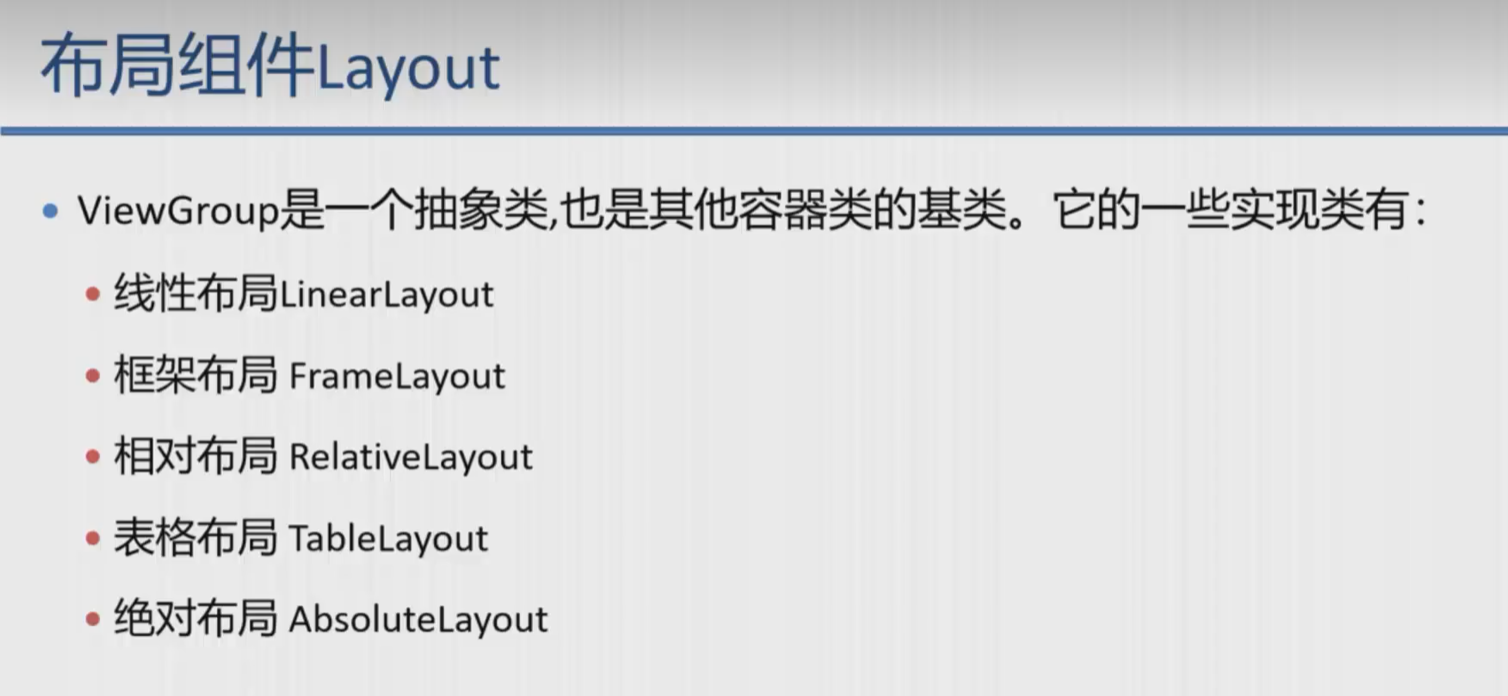
![[SSD科普] 固态硬盘物理接口SATA、M.2、PCIe常见疑问,如何选择?](https://img-blog.csdnimg.cn/img_convert/bd935ef409ed41ac81d233e736274501.png)
